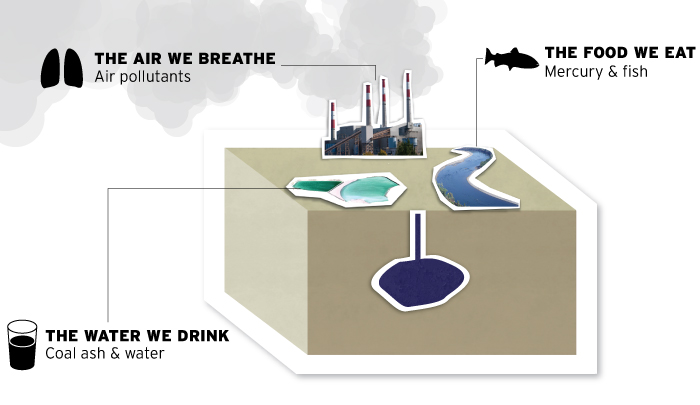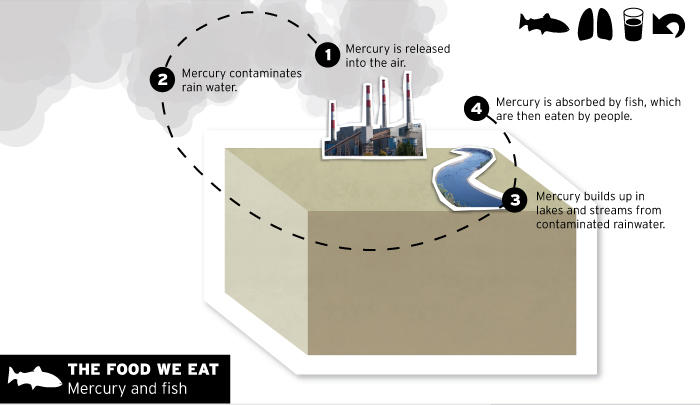Burning coal for electricity can damage our health through polluting the air we breathe, the water we drink and the food we eat.
Click on the lungs, the fish or the glass of water to explore these annual health impacts.

| THE COST OF COAL
The annual health costs from burning coal for electricity are $255 billion, according to the best estimates in a 2011 study from the Center for Health and the Global Environment at Harvard Medical School. The study states that costs may actually range from $86 billion to $423 billion, annually. Another by-product of burning coal is a waste called coal ash, which can contaminate our drinking water, resulting in further health impacts. |
| WHAT ARE AIR TOXICS & PM?
Air toxics are hazardous air pollutants known or suspected to cause serious health effects. Fine particulate matter (PM) is made up of tiny particles of dust, chemicals, acids and metals. |
WHAT IS THE GOVERNMENT DOING?
The Environmental Protection Agency (EPA) will finalize the Toxics Rule in Nov. 2011 to reduce emissions of air toxics and other pollutants from coal- and oil-fired electric power plants. Comment on the rule here until Aug. 4. |
WHY YOU SHOULD CARE
Potential health effects of air toxics:
Estimates for fine PM annual health effects:
|
| LEARN MORE
The Toxics Rule will reduce emissions of air toxics (hazardous air pollutants) from coal- and oil-fired power plants by setting emission limits. There are multiple technically and economically feasible practices, technologies and strategies for companies to meet these limits. |
||
| WHAT IS COAL ASH?
Coal ash is the material remaining after burning coal to produce electricity. The primary way to dispose of coal ash is by mixing it with water in coal ash ponds. |
WHAT IS THE GOVERNMENT DOING?
Initially, the Environmental Protection Agency (EPA) believed a final rule to regulate coal ash could be published July, 2011. This will not happen. Instead the EPA will likely release new available data to the public during the summer of 2011. |
WHY YOU SHOULD CARE
Coal ash contains toxics like arsenic, lead, mercury, cadmium and chromium that can cause:
|
| LEARN MORE
The toxics in coal ash can leach, or dissolve, out of the ash and into the pond water. They leak into above-ground waterways and underground water supplies, contaminating drinking water. In 2007, the EPA released a list of 24 proven damage cases and 43 potential damage cases in which groundwater had been contaminated. Some say there are now 101 total cases. Find ash ponds close to you. |
||

| WHAT IS MERCURY?
Mercury is a naturally occurring element. Methylmercury, which builds up in the environment, is the most common culprit type of mercury for health issues. |
WHAT IS THE GOVERNMENT DOING?
The Environmental Protection Agency (EPA) will finalize the Toxics Rule in Nov. 2011 to reduce emissions of mercury and other pollutants from coal- and oil-fired electric power plants. Comment on the rule here until Aug. 4. |
WHY YOU SHOULD CARE
Mercury can cause:
While mercury is naturally occurring:
|
| LEARN MORE
Mercury is released into the air when coal is burned. It accumulates in streams, lakes and oceans, where it is turned into methylmercury and absorbed by fish. When pregnant women, nursing mothers or young children eat these fish, there can be serious health impacts on the fetus, infant or young child. Learn more and see a list of fish advisories, or see how much mercury is emitted by plants close to you. |
||
CREDITS
Design by Kristen Long
Reporting by Jeff Mittelstadt
SOURCES
Health costs
Epstein, Paul R., et al. “Full cost accounting for the life cycle of coal.” Ann. N.Y. Acad. Sci. 1219 (2011), 73-98.
Hazardous air pollutants
EPA Technology Transfer Network Air Toxics.
EPA Office of Inspector General Air Toxics Monitoring Report. (PDF)
Particulate matter
EPA Particulate Matter.
